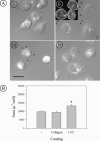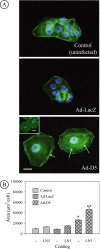Regulated synthesis and functions of laminin 5 in polarized madin-darby canine kidney epithelial cells
- PMID: 16775009
- PMCID: PMC1525223
- DOI: 10.1091/mbc.e05-11-1070
Regulated synthesis and functions of laminin 5 in polarized madin-darby canine kidney epithelial cells
Abstract
Renal tubular epithelial cells synthesize laminin (LN)5 during regeneration of the epithelium after ischemic injury. LN5 is a truncated laminin isoform of particular importance in the epidermis, but it is also constitutively expressed in a number of other epithelia. To investigate the role of LN5 in morphogenesis of a simple renal epithelium, we examined the synthesis and function of LN5 in the spreading, proliferation, wound-edge migration, and apical-basal polarization of Madin-Darby canine kidney (MDCK) cells. MDCK cells synthesize LN5 only when subconfluent, and they degrade the existing LN5 matrix when confluent. Through the use of small-interfering RNA to knockdown the LN5 alpha3 subunit, we were able to demonstrate that LN5 is necessary for cell proliferation and efficient wound-edge migration, but not apical-basal polarization. Surprisingly, suppression of LN5 production caused cells to spread much more extensively than normal on uncoated surfaces, and exogenous keratinocyte LN5 was unable to rescue this phenotype. MDCK cells also synthesized laminin alpha5, a component of LN10, that independent studies suggest may form an assembled basal lamina important for polarization. Overall, our findings indicate that LN5 is likely to play an important role in regulating cell spreading, migration, and proliferation during reconstitution of a continuous epithelium.
Figures










Similar articles
-
A cell signal pathway involving laminin-5, alpha3beta1 integrin, and mitogen-activated protein kinase can regulate epithelial cell proliferation.Mol Biol Cell. 1999 Feb;10(2):259-70. doi: 10.1091/mbc.10.2.259. Mol Biol Cell. 1999. PMID: 9950675 Free PMC article.
-
Laminin-6 is activated by proteolytic processing and regulates cellular adhesion and migration differently from laminin-5.J Biol Chem. 2002 Dec 20;277(51):49287-95. doi: 10.1074/jbc.M111096200. Epub 2002 Oct 11. J Biol Chem. 2002. PMID: 12379663
-
Expression of laminin-5 enhances tumorigenicity of human fibrosarcoma cells in nude mice.Jpn J Cancer Res. 2002 Jun;93(6):652-9. doi: 10.1111/j.1349-7006.2002.tb01303.x. Jpn J Cancer Res. 2002. PMID: 12079513 Free PMC article.
-
Integrins in epithelial cell polarity: using antibodies to analyze adhesive function and morphogenesis.Methods. 2003 Jul;30(3):235-46. doi: 10.1016/s1046-2023(03)00030-6. Methods. 2003. PMID: 12798138 Review.
-
Laminin-332-integrin interaction: a target for cancer therapy?Curr Med Chem. 2008;15(20):1968-75. doi: 10.2174/092986708785132834. Curr Med Chem. 2008. PMID: 18691052 Free PMC article. Review.
Cited by
-
Laminin 511 partners with laminin 332 to mediate directional migration of Madin-Darby canine kidney epithelial cells.Mol Biol Cell. 2012 Jan;23(1):121-36. doi: 10.1091/mbc.E11-08-0718. Epub 2011 Oct 26. Mol Biol Cell. 2012. PMID: 22031290 Free PMC article.
-
Laminins in Epithelial Cell Polarization: Old Questions in Search of New Answers.Cold Spring Harb Perspect Biol. 2017 Oct 3;9(10):a027920. doi: 10.1101/cshperspect.a027920. Cold Spring Harb Perspect Biol. 2017. PMID: 28159878 Free PMC article. Review.
-
Regulation of Kir4.1 and AQP4 expression and stability at the basolateral domain of epithelial MDCK cells by the extracellular matrix.Am J Physiol Renal Physiol. 2011 Aug;301(2):F396-409. doi: 10.1152/ajprenal.00315.2010. Epub 2011 May 4. Am J Physiol Renal Physiol. 2011. PMID: 21543416 Free PMC article.
-
Aberrant expression of laminin-332 promotes cell proliferation and cyst growth in ARPKD.Am J Physiol Renal Physiol. 2014 Mar 15;306(6):F640-54. doi: 10.1152/ajprenal.00104.2013. Epub 2013 Dec 26. Am J Physiol Renal Physiol. 2014. PMID: 24370592 Free PMC article.
-
Actin-ring segment switching drives nonadhesive gap closure.Proc Natl Acad Sci U S A. 2020 Dec 29;117(52):33263-33271. doi: 10.1073/pnas.2010960117. Epub 2020 Dec 14. Proc Natl Acad Sci U S A. 2020. PMID: 33318201 Free PMC article.
References
-
- Aumailley M., El Khal A., Knoss N., Tunggal L. Laminin 5 processing and its integration into the ECM. Matrix Biol. 2003;22:49–54. - PubMed
-
- Caplan M. J., Stow J. L., Newman A. P., Madri J., Anderson H. C., Farquhar M. G., Palade G. E., Jamieson J. D. Dependence on pH of polarized sorting of secreted proteins. Nature. 1987;329:632–635. - PubMed
-
- Carter W. G., Ryan M. C., Gahr P. J. Epiligrin, a new cell adhesion ligand for integrin α3β1 in epithelial basement membranes. Cell. 1991;65:599–610. - PubMed
-
- Cheng Y. S., Champliaud M. F., Burgeson R. E., Marinkovich M. P., Yurchenco P. D. Self-assembly of laminin isoforms. J. Biol. Chem. 1997;272:31525–31532. - PubMed
Publication types
MeSH terms
Substances
Grants and funding
LinkOut - more resources
Full Text Sources
Other Literature Sources

